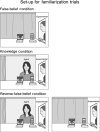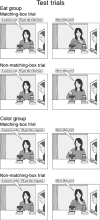False-belief understanding i 2.5-year-olds: evidence for violation-of-expectation change-of-location and unexpected-contents tasks
- PMID: 22213902
- PMCID: PMC3357329
- DOI: 10.1111/j.1467-7687.2010.00980.x
False-belief understanding i 2.5-year-olds: evidence for violation-of-expectation change-of-location and unexpected-contents tasks
Abstract
Until recently, it was generally assumed that the ability to attribute false beliefs did not emerge until about 4 years of age. However, recent reports using spontaneous- as opposed to elicited-response tasks have suggested that this ability may be present much earlier. To date, researchers have employed two kinds of spontaneous-response false-belief tasks: violation-of-expectation tasks have been used with infants in the second year of life, and anticipatory-looking tasks have been used with toddlers in the third year of life. In the present research, 2.5-year-old toddlers were tested in violation-of-expectation tasks involving a change-of-location situation (Experiment 1) and an unexpected-contents situation (Experiment 2). Results were positive in both situations, providing the first demonstrations of false-belief understanding in toddlers using violation-of-expectation tasks and, as such, pointing to a consistent and continuous picture of early false-belief understanding.
Figures






Similar articles
-
2.5-year-olds succeed at a verbal anticipatory-looking false-belief task.Br J Dev Psychol. 2012 Mar;30(Pt 1):14-29. doi: 10.1111/j.2044-835X.2011.02070.x. Epub 2011 Nov 17. Br J Dev Psychol. 2012. PMID: 22429030 Free PMC article.
-
False-belief understanding in infants.Trends Cogn Sci. 2010 Mar;14(3):110-8. doi: 10.1016/j.tics.2009.12.006. Epub 2010 Jan 27. Trends Cogn Sci. 2010. PMID: 20106714 Free PMC article. Review.
-
False-belief understanding in 2.5-year-olds: evidence from two novel verbal spontaneous-response tasks.Dev Sci. 2012 Mar;15(2):181-93. doi: 10.1111/j.1467-7687.2011.01103.x. Epub 2011 Nov 2. Dev Sci. 2012. PMID: 22356174 Free PMC article.
-
Processing Demands Impact 3-Year-Olds' Performance in a Spontaneous-Response Task: New Evidence for the Processing-Load Account of Early False-Belief Understanding.PLoS One. 2015 Nov 12;10(11):e0142405. doi: 10.1371/journal.pone.0142405. eCollection 2015. PLoS One. 2015. PMID: 26562840 Free PMC article.
-
Infants' performance in spontaneous-response false belief tasks: A review and meta-analysis.Infant Behav Dev. 2019 Nov;57:101350. doi: 10.1016/j.infbeh.2019.101350. Epub 2019 Aug 21. Infant Behav Dev. 2019. PMID: 31445431 Review.
Cited by
-
2.5-year-olds succeed at a verbal anticipatory-looking false-belief task.Br J Dev Psychol. 2012 Mar;30(Pt 1):14-29. doi: 10.1111/j.2044-835X.2011.02070.x. Epub 2011 Nov 17. Br J Dev Psychol. 2012. PMID: 22429030 Free PMC article.
-
Monkeys represent others' knowledge but not their beliefs.Dev Sci. 2011 Nov;14(6):1406-16. doi: 10.1111/j.1467-7687.2011.01085.x. Epub 2011 Aug 30. Dev Sci. 2011. PMID: 22010899 Free PMC article.
-
Dissociation of understanding from applying others' false beliefs in remitted schizophrenia: evidence from a computerized referential communication task.BMC Psychiatry. 2013 May 17;13:141. doi: 10.1186/1471-244X-13-141. BMC Psychiatry. 2013. PMID: 23683146 Free PMC article.
-
False-belief understanding in infants.Trends Cogn Sci. 2010 Mar;14(3):110-8. doi: 10.1016/j.tics.2009.12.006. Epub 2010 Jan 27. Trends Cogn Sci. 2010. PMID: 20106714 Free PMC article. Review.
-
Probing the depth of infants' theory of mind: disunity in performance across paradigms.Dev Sci. 2018 Jul;21(4):e12600. doi: 10.1111/desc.12600. Epub 2017 Sep 27. Dev Sci. 2018. PMID: 28952180 Free PMC article.
References
-
- Apperly IA, Butterfill SA. Do humans have two systems to track beliefs and belief-like states? Psychological Review. 2009;11:953–970. - PubMed
-
- Baron-Cohen S, Leslie AM, Frith U. Does the autistic child have a `theory of mind'? Cognition. 1985;21:37–46. - PubMed
-
- Birch SAJ, Bloom P. Children are cursed: an asymmetric bias in mental-state attribution. Psychological Science. 2003;14:283–286. - PubMed
-
- Bolz M, He Z, Baillargeon R. 2.5-year-olds expect another person to answer correctly when asked where an agent with a false belief will look for her toy. Paper presented at the Biennial Meeting of the Society for Research in Child Development; Denver, CO. Apr, 2009.
Publication types
MeSH terms
Grants and funding
LinkOut - more resources
Full Text Sources

